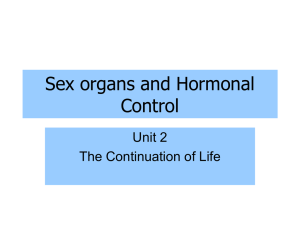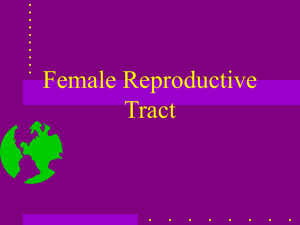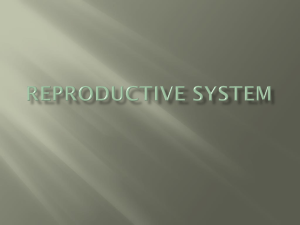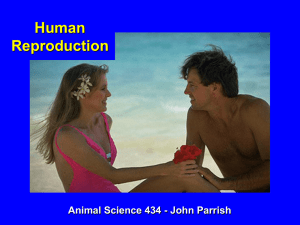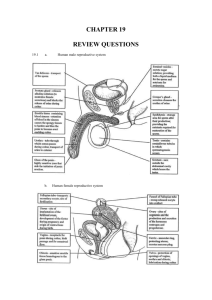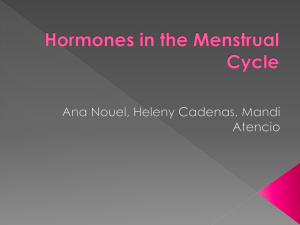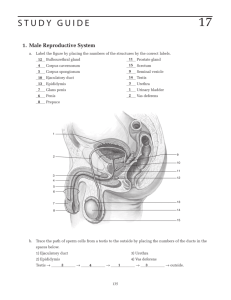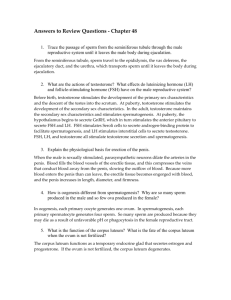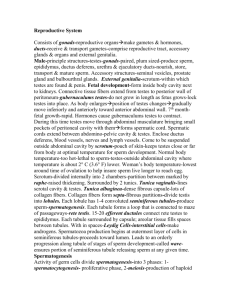Chapter 28
advertisement
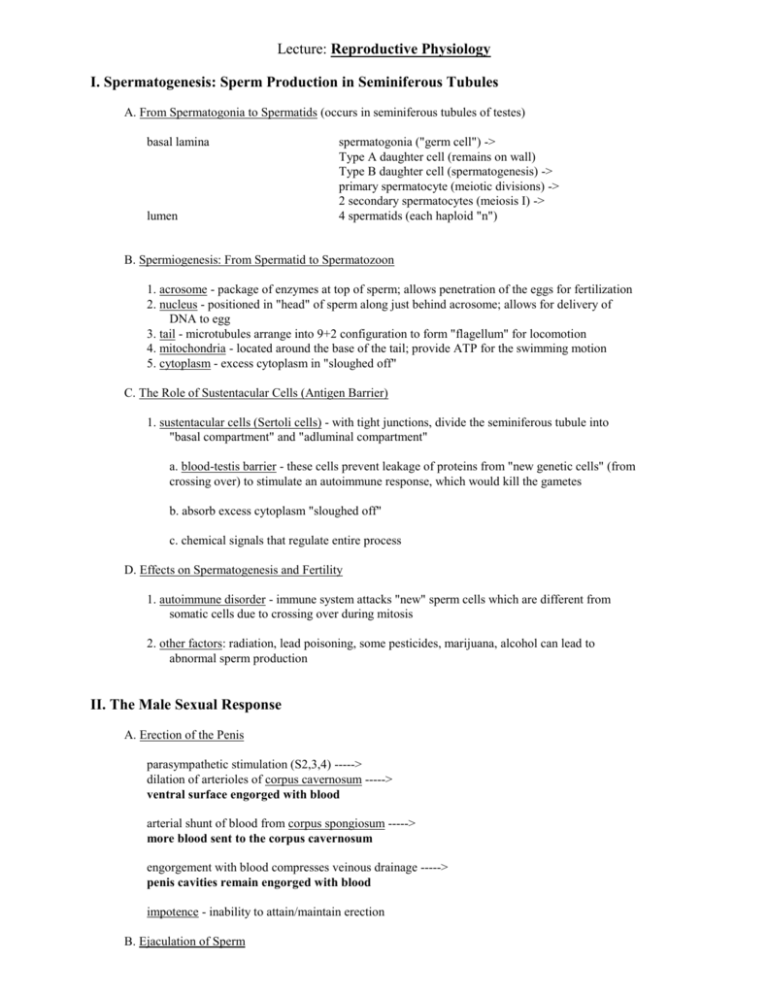
Lecture: Reproductive Physiology I. Spermatogenesis: Sperm Production in Seminiferous Tubules A. From Spermatogonia to Spermatids (occurs in seminiferous tubules of testes) basal lamina lumen spermatogonia ("germ cell") -> Type A daughter cell (remains on wall) Type B daughter cell (spermatogenesis) -> primary spermatocyte (meiotic divisions) -> 2 secondary spermatocytes (meiosis I) -> 4 spermatids (each haploid "n") B. Spermiogenesis: From Spermatid to Spermatozoon 1. acrosome - package of enzymes at top of sperm; allows penetration of the eggs for fertilization 2. nucleus - positioned in "head" of sperm along just behind acrosome; allows for delivery of DNA to egg 3. tail - microtubules arrange into 9+2 configuration to form "flagellum" for locomotion 4. mitochondria - located around the base of the tail; provide ATP for the swimming motion 5. cytoplasm - excess cytoplasm in "sloughed off" C. The Role of Sustentacular Cells (Antigen Barrier) 1. sustentacular cells (Sertoli cells) - with tight junctions, divide the seminiferous tubule into "basal compartment" and "adluminal compartment" a. blood-testis barrier - these cells prevent leakage of proteins from "new genetic cells" (from crossing over) to stimulate an autoimmune response, which would kill the gametes b. absorb excess cytoplasm "sloughed off" c. chemical signals that regulate entire process D. Effects on Spermatogenesis and Fertility 1. autoimmune disorder - immune system attacks "new" sperm cells which are different from somatic cells due to crossing over during mitosis 2. other factors: radiation, lead poisoning, some pesticides, marijuana, alcohol can lead to abnormal sperm production II. The Male Sexual Response A. Erection of the Penis parasympathetic stimulation (S2,3,4) -----> dilation of arterioles of corpus cavernosum -----> ventral surface engorged with blood arterial shunt of blood from corpus spongiosum -----> more blood sent to the corpus cavernosum engorgement with blood compresses veinous drainage -----> penis cavities remain engorged with blood impotence - inability to attain/maintain erection B. Ejaculation of Sperm sensory impulses reach critical level -----> sympathetic activation of testes tubules -----> reproductive ducts/glands contract peristaltically -----> bladder sphincter muscle constricts (no urine) -----> sperm moves into the urethra -----> bulbospongiosus muscles contract to expel semen IV. Hormonal Regulation of Male Reproduction A. Brain-Testicular Hormone Axis hypothalamus gonadotropin releasing hormone (GnRH) ----> anterior pituitary follicle stimulating hormone (FSH) + luteinizing hormone (LH) -----> Blood CIRCULATION -------> testes FSH ----> androgen-binding protein (ABP) ABP ----> concentrating testosterone testosterone -----> stimulate spermatogenesis LH -> testosterone (from interstitial cells) Negative Feedback testosterone INHIBITS release of GnRH inhibin INHIBITS release of FSH B. Mechanism and Effects of Testosterone 1. Mechanism of Action a. testosterone passes through cell membrane (lipid) b. binds to "hormone receptor" in the nucleus c. "hormone-receptor complex" binds to acceptor on gene d. DNA of gene is translated into mRNA e. mRNA directs protein synthesis in cytoplasm 2. Synthesis of sex hormones in males a. prostate testosterone -> dihydroxytestosterone b. some neurons - testosterone -> estrogen 3. Effects of Targets a. testes - stimulates spermatogenesis b. ducts, glands, penis - essential for growth/maintain c. secondary sex characteristics - develop at puberty i. pubic, axillary, facial, chest hair growth ii. increase in bone & muscle size iii. sex drive for Males & Females Lecture: Female Reproductive Physiology I. Oogenesis: Production of Eggs A. Overview of Timing/Location of Oogenic Meiosis fetus: oogonia (diploid stem cells) ------> primary oocytes w/ follicle cells (prim. follicle) ------> primary oocyte arrested in Prophase I (ovary cortex) childhood: about 700,000 primary oocytes ready to go puberty: primary oocyte (primordial follicle) ------> completes Meiosis I to produce 2 haploid cells ------> secondary oocyte + first polar body ovulation: secondary oocyte released by ovary fertilization: sperm penetrates secondary oocyte ------> completion of Meiosis II to produce ------> 1 very large haploid OVUM + polar body B. Important Notes About Oogenesis vs. Spermatogenesis 1. Oogenesis: a. all potential gametes produced before birth b. Meiotic divisions unequal, leading to the formation of polar bodies (eventually destroyed) c. puberty releases the "arrested state" of primary oocytes, leading to ovulation d. Meiosis II does not occur until fertilization of the secondary oocyte by mature sperm e. ovulation and reproduction naturally end during menopause 2. Spermatogenesis: a. spermatogenesis from spermatogenic cells starts at puberty and continues through life b. Meiotic divisions are equal, leading to 4 spermatozoa from original spermatogenic cell c. Meiosis II completed before the sperm leads to fertilization II. The Ovarian Cycle (typically 28 day cycle) A. follicular phase (days 1-10 of cycle) 1. primordial follicle ------> primary follicle (squamous cells) (cuboidal cells) 2. primary follicle ------> secondary follicle follicle cells ------> stratified epithelium (granulosa) 3. ovary cortex forms theca folliculi around granulosa theca folliculi & granulosa produce estrogens 4. granulosa form jelly-like zona pellucida 5. fluid-filled space called antrum develops 6. primary follicle now becomes a secondary follicle granulosa cells begin to form corona radiata secondary (vesicular) follicle reaches ovary surface B. ovulatory phase (days 11-14 of cycle) 1. fluid filled antrum increases in size corona radiata begins to separate from wall 2. ovulation - secondary oocyte (surrounded by the corona radiata) bursts from the ovary into the peritoneal cavity (fimbriae pick up!) a. mittelschmerz - pain associated with ovulation C. luteal phase (days 14-28 of cycle) 1. corpus luteum forms from granulosa and thecal cells remaining from the bursting site; it secretes progesterone and some estrogen a. YES pregnancy -> secrete more progesterone b. NO pregnancy -> whole structure will degenerate (no more progesterone) III. Hormonal Regulation of Ovarian Cycle A. Early Phases Before Ovarian Cycle childhood ovaries secrete small amounts of estrogens ------> block hypothalamic release of GnRH (no FSH or LH secreted from anterior pituitary) early puberty hypothalamus less INHIBITED by estrogens -----> gradually more GnRH is released ------> gradually more FSH and LH released late puberty GnRH released more cyclicly -----> FSH and LH released cyclicly -----> menarche - first menstrual period (bleeding) B. Hormonal Interactions During Ovarian Cycle 1. GnRH, LH, FSH and their Role in Estrogen Level a. increasing release of GnRH from hypothalamus -----> increased release of FSH and LH from ant. pituitary -----> FSH stimulates growth/division of follicle cells LH stimulates development of thecal cells LH stimulates thecal cells to produce androgens FSH stimulates granulosa to convert to estrogens b. temporary NEGATIVE FEEDBACK - these low levels of estrogens briefly inhibits more release of FSH and LH (although it is still being produced and stored!) c. temporary POSITIVE FEEDBACK - these low levels of estrogens briefly enhance FSH stimulation of granulosa 2. Higher Estrogen Leads to Actions of LH a. estrogen levels eventually get higher and higher b. suddenly, high estrogen creates POSITIVE FEEDBACK to brain increasing GnRH, FSH, LH levels c. LH and FSH levels rise very quickly (MIDCYCLE) d. high LH level increases fluid level in antrum, and rupture/release of the secondary oocyte e. estrogen level drops immediately after ovulation, but soon begins to rise again f. LH stimulates "corpus luteum" to secrete progesterone to prepare the endometrium for implantation and pregnancy 3. Continuation Depends on Corpus Luteum and Progesterone a. progesterone and estrogen levels rise, leading to a NEGATIVE FEEDBACK on LH and FSH from anterior pituitary b. LH levels decline, corpus luteum starts to degenerate, and less progesterone released PREGNANCY -------> placenta releases Human Chorionic Gonadotropin, (maintaining progesterone levels for pregnancy) C. The Menstrual (Uterine) Cycle 1. proliferative phase of Uterine Cycle (days 6-14) a. rising levels of estrogen allow "repair" of stratum basalis of the endometrium; also causes thickening of stratum functionalis, increasing vasculature, making progesterone receptors 2. secretory phase of Uterine Cycle (days 15-28) a. rising levels of progesterone (from corpus luteum) increase thickness and vasculature to the endometrium 3. menstrual phase of Uterine Cycle (days 1-5) NO PREGNANCY -------> -------> -------> no Human Chorionic Gonadotropin no more progesterone (corpus luteum gone) endometrium “sloughs off” and bleeding occurs IV. Contraception A. Male Contraception 1. vasectomy - the vas Deferens is cut and tied so that, sperm cannot proceed 2. condom - prevents sperm from entering the vagina; can prevent STD transmission 3. drugs - some drugs for men may be on the market soon 4. coitus interuptus - penis removed before ejaculation B. Female Contraception 1. birth control pill - small amounts of estrogens (estradiol, estrone, or estriol) and progestins (progesterone analogues) given on days 1-23 of ovarian-menstrual cycle a. mimicry - the hormones "mimic" the pregnant state, fooling the ovaries so that ovulation is discontinued, eggs not released b. side effects - nausea, hypertension, depression in some women; research is conflicting on effects on breast/uterine cancers c. Norplant - small stick placed under the skin that slowly releases progesterone 2. intrauterine device (IUD) - placed in uterus, blocks implantation of fertilized egg; serious problems in past with bleeding and infections 3. tubal ligation - uterine tubes "tied off" to prevent eggs an sperm from fertilizing 4. diethylstilbestrol (DES) - morning after pill; prevents implantation of egg 5. RU-486 (mifepristone) - blocks the action of progesterone on a pregnant uterus; used with prostaglandin, fetus is expelled in time 6. inhibin - blocks anterior pituitary release of FSH 7. Anti-HCG vaccine - blocks Human Chorionic Gonadotropin Most Effective Contraceptive: ABSTINENCE !!!!!!!!!!!!!! V. Extrauterine Effects of Estrogens & Progesterone A. Role of Estrogens 1. cause maturation of sex organs at puberty 2. cause increased growth in girls aged 11-13 3. Secondary Sex Characteristics: breast growth, increased fat on hips & breasts, widening of pelvis, axillary & pubic hair, facilitate Ca++ uptake B. Role of Progesterone 1. regulates uterine cycle with estrogens 2. prepares uterus for pregnancy 3. prepares breasts for lactation VI. Female Sexual Response A. General Features 1. same autonomics (S2,3,4) stimulate excitation of clitoris, vagina, breasts, and lubrication 2. multiple orgasms possible, but not essential for pregnancy to occur VII. Sexually Transmitted Diseases (STDs) (Venereal Diseases) A. AIDS (Acquired Immune Deficiency Syndrome) 1. human immunodeficiency virus (HIV) - infects helper T cells and suppresses immune response 2. opportunistic infections - immunodeficiency leads to normal and rare infections (viral and bacterial) B. Gonorrhea 1. Neisseria gonorrhoeae - bacteria that causes disease 2. male symptoms - "urethritis" and inflammation through the urogenital tract 3. female symptoms - vaginal discharge, uterine bleeding, abdominal pains 4. penicillin used to treat effectively D. Syphilis 1. Treponema pallidum - bacteria that causes disease 2. easily transmitted to fetus -> stillbirth 3. chancre - sore that appears after incubation period 4. secondary signs - pinkish color on skin, anemia, and loss of hair 5. tertiary syphilis - "gummas" - lesions of the CNS, vasculature, bones and skin 6. penicillin used to treat all stages E. Chlamydia 1. Chlamydia trachomatis - bacteria that causes disease 2. most common STD in the US today 3. symptoms - urethritis, vaginal discharge, painful intercourse, irregular bleeding in women 4. tetracycline used for treatment F. Genital Herpes 1. herpes simplex virus 2 - cause of genital herpes 2. painful lesions on penis and vulva 3. can lead to cervical cancer 4. no "cure" for viral infection

